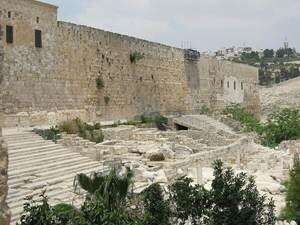“How beautiful and lovely … “
05. Apr. 2024 / Science & Research
"How beautiful and lovely when brothers ... get into each other's hair."
The pilgrimage songs as an example of constructive community togetherness
One of the memories that travelers bring back from their trip to Jerusalem is the constant ascent and descent through the city, the fascinating religious center for Jews, Christians and Muslims. If you want to visit the Temple Mount, you have to walk up stairs or narrow inclines, or if you want to visit the Mount of Olives, you first have to descend into the Kidron Valley and then begin the steep ascent to Gethsemane and further up to the summit of the Mount of Olives. You have to climb up from everywhere in Israel to get to Jerusalem.
In biblical times, pilgrims from all over Israel (and beyond) would make the long journey to Jerusalem to pray in the Temple for the three great annual festivals: Rosh Hashanah (the Jewish New Year), Yom Kippur (the Day of Atonement) and Sukkot (the Feast of Tabernacles). Their route took them past the Pool of Siloam and ended at the southern steps leading up to the city wall. There were two gates on the western and eastern sides of the huge flight of steps (approx. 61 m long), one on the western and one on the eastern side of the staircase, which provided both an entrance to the Temple Mount and an exit to facilitate the flow of pilgrims through the temple grounds. Today, both gates, named after the prophetess Hulda, are blocked. The inner gates, which used to lead to the top of the Temple Mount, have been rededicated and repurposed for the Muslim religious sites on the Mount. The staircase was originally excavated by Benjamin Mazar in 1967 and now forms part of the Jerusalem Archaeological Park.
The staircase consists of fifteen relatively wide steps (90 cm), each interrupted by two narrow steps (30 cm), which provide fifteen wider stands from which the ancient rabbis could have proclaimed their teachings or from which even Jesus could have taught the people (Luke 21:37-38). There are fifteen pilgrim songs in the Book of Psalms, also known as the Songs of Ascents (Psalms 120–134). It is possible that these fifteen songs were sung one after the other on each further broad step. This is where the message of the Songs of Ascent is located: between a city gate somewhere in Israel and the temple gates in Jerusalem; between a farmer's field and Mount Zion; between a nursing child and the peace of God; and finally between a family meal and divine blessing.
This tradition is still very much alive today, and as visitors walk up the southern staircase, pausing at each wider step to recite the Songs of Ascent, one can still hear the uplifting words of the psalmists who wrote about deliverance from bondage and the mystery of living together in harmony in a community of faith.
By immersing themselves together in the ancient texts and reciting or singing these psalms together, people who live in tension with one another also find a good opportunity to bring their disputes before God together and experience blessing (Text: Prof. Martin Klingbeil, has been teaching Old Testament and Biblical Hebrew at the FAU since 2023 | Image rights: Tempelberg-Suedwall. Commons.wikimedia.org_.jpgcommons.wiki).
